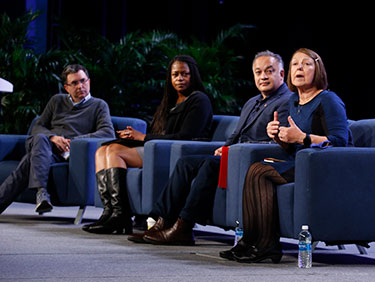Over 1 million people in the U.S. have died from COVID-19, and nearly 100 million have been infected. The pandemic has not only had an impact on mortality and health but also people’s incomes and nearly every other part of their everyday lives.
During Tuesday’s APHA 2022 session “COVID-19 The Great Pandemic: What’s Next?” panelists weighed in on what was learned during the pandemic and how best to apply lessons in the future.
In the pandemic’s early days in March 2020, public health officials struggled to communicate with the public, panelists acknowledged, revealing a communication gap in their training. 
“We live in a world where we don’t have to be clear communicators,” said Bisola Ojikutu, executive director of the Boston Public Health Commission. “We just think everyone will follow our direction.”
Umair Shah, secretary of health for Washington state, advised on mammograms when he was a practicing physician, but rarely told patients the story of his aunt dying of stage 4 breast cancer and how deeply her death affected him.
In medical school, professors advise students not to talk about personal health experiences, Shah said. But he noticed that when he started talking about his aunt, patients were more receptive to mammograms.
Public health leaders should not only bone up on communication, but they should also feel comfortable talking about personal experiences to people in need, he said.
Catherine Troisi, associate professor of management, policy and community health at UT Health Houston School of Public Health, said words matter, whether talking to a patient or at a public health news conference.
For example, don’t use phrases such as “surveillance” and “upstream regulation” when speaking in the community, she said. When the public hear “surveillance,” they thinks it means “tapping their phone.”
Trusted messengers have played an important role in increasing COVID-19 vaccination rates in communities of color during the pandemic. Messengers have included barbers, pastors, schools and popular community leaders.
During the pandemic, Shah’s team enlisted local sports teams as trusted messengers to reduce vaccine hesitancy in neighborhoods of color and in working-class white neighborhoods. The state also embraced locally based companies such as Costco, Starbucks, Alaska Air and smaller businesses as vaccine messengers.
Data show both approaches were effective. The connection to Starbucks, for example, may have led to a 30% bump in vaccination in some communities, Shah said.
Hiring community health workers has also been effective for health education during the pandemic. The Baltimore City Health Department hired 80 people as COVID-19 ambassadors, who are trusted community messengers who talk to residents about vaccination. This summer, the health department adapted its COVID-19 outreach messaging to monkeypox vaccinations, bringing aboard ambassadors for that campaign as well. They focused on the LGBTQ community and promotion of vaccination events, The Nation’s Health reported.
In Maryland, community health workers, lay people who are used for health outreach, have been so impactful that the Maryland Department of Health is expanding its accreditation for community health worker training programs.
Public health made many advances during COVID-19, Shah said. But the challenge will be to hold on to what worked and apply those ideas and methods to other public health challenges.
“The biggest fear we have is that we got together and fought a pandemic and we forgot what we learned and it is going away,” he said.
Photo, from left to right, Joshua Sharfstein, Bisola Ojikutu, Umair Shah and Catherine Troisi. Photo courtesy of EZ Event Photography.